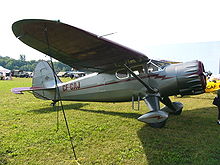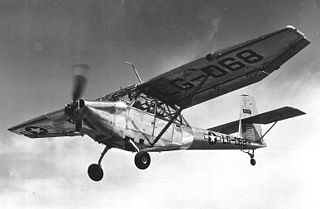
The Stinson L-13 was a US military utility aircraft first flown in 1945.

The Stinson 108 is a popular single-engine, four-seat, light general aviation aircraft produced by the Stinson division of the American airplane company Consolidated Vultee, from immediately after World War II to 1950. The 108 was developed from the prewar Model 10A Voyager.

The Howard DGA-15 was a single-engine civil aircraft produced in the United States by the Howard Aircraft Corporation from 1939 to 1944. After the United States' entry into World War II, it was built in large numbers for the United States Navy and also served various roles in the United States Army Air Forces.

The Howard DGA-8, DGA-9, DGA-11, and DGA-12 were a family of four-place, single-engine, high-wing light monoplanes built by the Howard Aircraft Corporation, Chicago, Illinois from 1936.

The Waco Custom Cabins were a series of up-market single-engined four-to-five-seat cabin sesquiplanes of the late 1930s produced by the Waco Aircraft Company of the United States. "Custom Cabin" was Waco's own description of the aircraft which despite minor differences, were all fabric-covered biplanes.
C-72 was a blanket designation given to a variety of privately owned Waco enclosed-cabin biplanes pressed into service by the United States Army Air Forces in 1942. In all, 42 aircraft were taken and used for light transport duty wherever needed.

The Cessna Airmaster, is a family of single-engined aircraft manufactured by the Cessna Aircraft Company. The Airmaster played an important role in the revitalization of Cessna in the 1930s after the crash of the aviation industry during the Great Depression.

The Waco Aircraft Company (WACO) was an aircraft manufacturer located in Troy, Ohio, United States. Between 1920 and 1947, the company produced a wide range of civilian biplanes.

The Wright R-760 Whirlwind was a series of seven-cylinder air-cooled radial aircraft engines built by the Wright Aeronautical division of Curtiss-Wright. These engines had a displacement of 756 in³ (12.4 L) and power ratings of 225-350 hp (168-261 kW).

The Stinson Voyager was an American light utility monoplane built during the 1940s by the Stinson Aircraft Company.

The Consolidated Model 21 was an American two-seat training aircraft built by the Consolidated Aircraft Company. It was used by the United States Army Air Corps with the designation PT-11 and the United States Coast Guard under the designation N4Y.
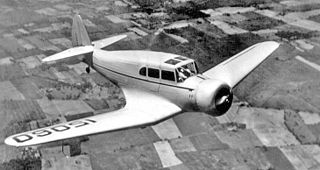
The Fairchild Model 45 was a 1930s American five-seat cabin monoplane aircraft designed and built by Fairchild.
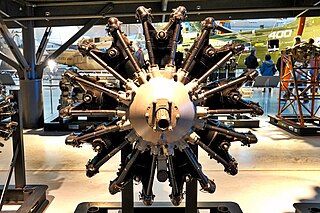
The Lycoming R-680 is a nine-cylinder air-cooled radial engine, the first aero engine produced by Lycoming. The engine was produced in two types, the E and B series; both are essentially the same. The B4E was available in a trainer version with a front exhaust collector "ring" for use without cylinder air baffles. R-680 received Approved Type Certificate No. 42 on 4 Feb 1930.

The Stinson SM-6000 Airliner was a 1930s three-engined (trimotor) ten-passenger airliner designed and built by the Stinson Aircraft Corporation. The SM-6000 was a high-wing braced monoplane with room for a pilot and a cabin for ten passengers. It was powered by three 215 hp (160 kW) Lycoming R-680 engines strut-mounted one each side above the main landing gear units and one in the nose. A number of variants were built mainly with improved interiors. In 1932 the Model U Airliner was produced which had low-set stub wings with an engine mounted at each wingtip.
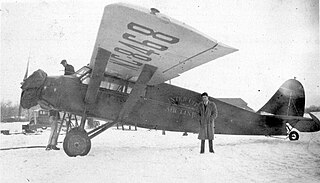
The Stinson Detroiter was a six-seat cabin airliner for passengers or freight designed and built by the Stinson Aircraft Syndicate, later the Stinson Aircraft Corporation. Two distinct designs used the Detroiter name, a biplane and a monoplane.
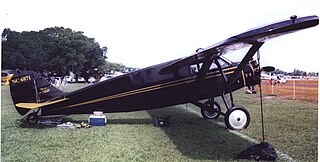
The Stinson Junior was a high-winged American monoplane of the late 1920s, built for private owners, and was one of the first such designs to feature a fully enclosed cabin.

The Waco Standard Cabin series is a range of American single-engine 4–5 seat fabric covered cabin biplanes produced by the Waco Aircraft Company beginning in 1931 with the QDC and continuing until 1942 when production ended for the VKS-7F. They were used as light passenger and utility transports, navigational trainers, bushplanes and briefly as maritime reconnaissance aircraft during World War 2.

The Waco E series is a small family of American-built cabin biplanes built between 1939 and 1942, which differed primarily by engine installation.

The Stinson Model O was an American single-engined military trainer aircraft of the 1930s designed built by the Stinson Aircraft Company. Based on the Stinson SR, the Model O was designed to meet a requirement of the Honduran Air Force, forming the initial equipment of that air arm.

The Stinson Model R was an American light aircraft built by the Stinson Aircraft Company in the early 1930s. It was a single-engine high-winged monoplane, developed from the Stinson Junior. 39 units were built.





